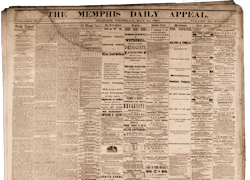The Memphis Daily Appeal
Memphis, Tennessee
June 22, 1861
By the kindness of Mr. Trezevant, we were yesterday admitted within the Confederate Government saber manufactory, on the south-east corner of Monroe and Third streets, over which establishment we were obligingly shown by the efficient superintendent and inspector, Lieut. Sengstack. On mounting to the immense room up stairs, we found four large tables ranged from end to end of the room, and at these tables two hundred and fifty women and girls, principally young girls, were busily engaged in the labor of preparing cartridges. The paper is rapidly passed round a stick, giving the required shape and size, then three buck shot and a bullet are placed at the bottom of it and held in their place by threads neatly and quickly tied round them. These are passed to others, who, placing a small funnel into the top of the paper tube deposit within, from a small measure, the required quantity of gunpowder. Others folded up the end of the paper and the cartridge was completed. Ten cartridges are next tied together in a package, and a given number of them are packed in a box, marked and certified as inspected, when they are ready for army use. So efficient is this department that already as many as seventy-five thousand cartridges have been turned out in one day. We need scarcely observe that every precaution is used to prevent explosion. Smoking is prohibited, matches are excluded, iron is as far as possible banished, and the men who have to pass along the room wear slippers. Beside cartridges, fixed ammunition, (consisting of powder and ball, so arranged as all to be placed in the cannon together) fuses for bombshells, rockets, signal lights, friction tubes for cannon, and other combustibles and implements are manufactured. These branches are carried on in a building entirely separate from that in which the cartridges are at work. At the distance of half a block from either of these departments, is the casting house, where round and minnie [sic] rifle bullets are cast in large quantities; over two thousand pounds of lead are moulded [sic] most days. In giving employment, the widows, wives, and families of soldiers, have the first preference. The women are paid four dollars and a half a week, the girls three dollars; when by extraordinary industry a certain number per day are made, a dollar a day is given. No less than two hundred and eighty-five persons are employed, of whom two hundred and thirty are females. The wages paid amount to over seven hundred and twenty-five dollars per week. What is most remarkable about the laboratory is the celerity and quietude with which it has been got into successful operation. Less than three weeks ago the place was filled with hay and other material, no magazine was built, no implements, seats or conveniences were there; now, owing to the energy of Col. W. R. Hunt and Lieut. Sengstack, hundreds of work-people are toiling and ordnance stores are ready to be put on trains or boats at the shortest notice; cannon-balls of various sizes, shells, canister, grape and other shot are packed ready for immediate transportation.
